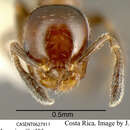en
names in breadcrumbs


The types of M. mexicana were collected in hollow twigs in southern Mexico. A dealate queen at USNM was intercepted by Brownsville quarantine in an orchid stem from the Canal Zone in Panama. At La Selva Biological Station and on the Barva transect in Braulio Carrillo National Park it has been collected in several Project ALAS Malaise and canopy fogging samples, from 50 to 500m elevation.
At La Selva I found a colony in a small dead stem in the crown of a recently felled Carapa guianensis. The relict tree was somewhat isolated in low second growth vegetation, and there were abundant vines over the crown, mainly Marcgraviaceae. The colony was polygynous, with multiple dealate queens. In the field, the tiny workers looked like small Solenopsis or Monomorium floricola.
Mexico, Costa Rica, Panama. In Costa Rica it is known from La Selva Biological Station and Arenal National Park (Longino 2006).
Taxonomic history
Combination in Myrmelachista (Hincksidris): Kempf, 1972b PDF: 149.See also Longino, 2006a PDF: 39.Myrmelachista mexicana Wheeler 1934:200. Syntype workers, queen, males: Mexico , Veracruz , Mirador ( Skwarra #296), in hollow twigs [ MCZC , USNM ] (USNM syntype worker examined) . Combination in M. (Hincksidris) : Kempf, 1972:149.
Diagnosis
Worker with antenna 10-segmented, face shiny, HW less than 0.5mm.
Worker
Antenna 10-segmented; maxillary palpus 6-segmented; mandible, clypeus, and face smooth and shining; in full face view, sides of head with sparse, short, appressed pubescence, no erect setae; rear margin of head with longer erect setae; ventral surface of head with very sparse, very short appressed pubescence, no erect setae; hind tibia with abundant appressed to suberect setae, pilosity short, about 1/4 width of tibia; mesosoma strongly constricted at metanotal groove, hourglass-shaped; dorsal face of propodeum with faint to pronounced reticulate sculpture; petiole in side view with low, rounded node, short anterior peduncle and long posterior peduncle; bicolored, with light red brown head and mesosoma, dark brown gaster, or grading to more uniformly dark red brown coloration. Also see description of Wheeler (1934).
Measurements: HL 0.438-0.471, HW 0.389-0.423, SL 0.256-0.292, EL 0.093-0.100, CI 87-90 (n=5).
Queen
Similar to worker in meristic characters, patterns of sculpture, pilosity, coloration. Labrum short, bilobed. Also see description of Wheeler (1934).
Measurements: HL 0.570-0.599, HW 0.483-0.484, SL 0.285-0.297, EL 0.175-0.180, OW 0.032, OD 0.147-0.156, CI 81-85, OI 36-37, OcI 5-6 (n=2).
Male
See description of Wheeler (1934). Wheeler’s figure of male genitalia show similarities to zeledoni , with blunt basiparamere lobe and paramere, and strongly upturned penial valve (suggesting that apodeme meets dorsal margin at right angle, like zeledoni ). The volsella is not visible in the illustration, suggesting it is short and downturned, like zeledoni . Pygostyles are not shown, suggesting they are absent or minute.
Range
Mexico, Costa Rica, Panama. In Costa Rica it is known from La Selva Biological Station and Arenal National Park.
Biology
The types of M. mexicana were collected in hollow twigs in southern Mexico. A dealate queen at USNM was intercepted by Brownsville quarantine in an orchid stem from the Canal Zone in Panama. At La Selva Biological Station and on the Barva transect in Braulio Carrillo National Park it has been collected in several Project ALAS Malaise and canopy fogging samples, from 50 to 500m elevation.
At La Selva I found a colony in a small dead stem in the crown of a recently felled Carapa guianensis . The relict tree was somewhat isolated in low second growth vegetation, and there were abundant vines over the crown, mainly Marcgraviaceae. The colony was polygynous, with multiple dealate queens. In the field, the tiny workers looked like small Solenopsis or Monomorium floricola .
Material Examined
COSTA RICA , Alajuela : Par. Nac. Arenal, La Peninsula , 10°27’N , 84°45’W , 600m ( J. S. Noyes ) ; Heredia : La Selva Biological Station , 10°26’N , 84°01’W , 50m ( ALAS ) ; same data ( J. Longino , 3 collections) ; MEXICO , Veracruz : Mirador , 19°13’N , 96°51’W ( E. Skwarra ) [ USNM ] ; PANAMA , Canal Zone : Canal Zone (Brownsville Quarantine) [ USNM ] .